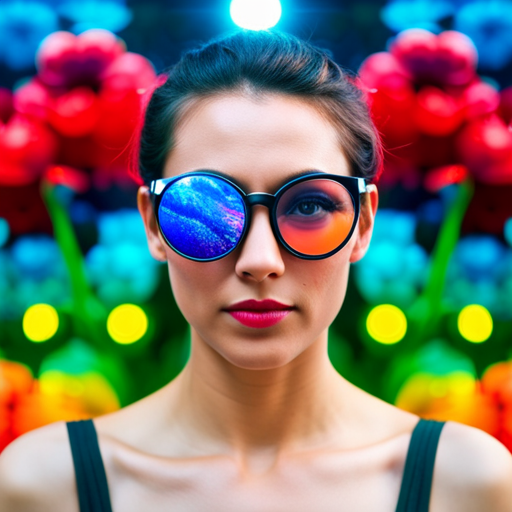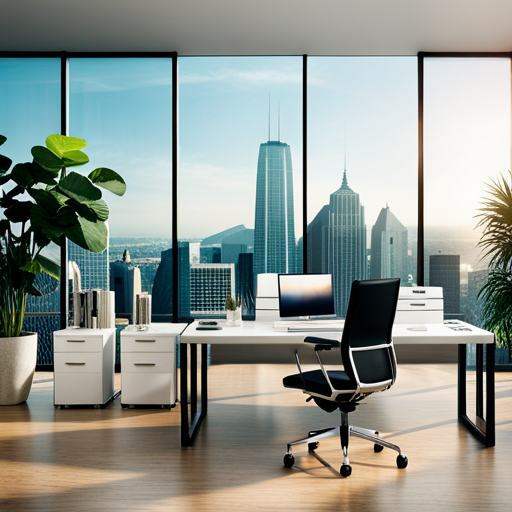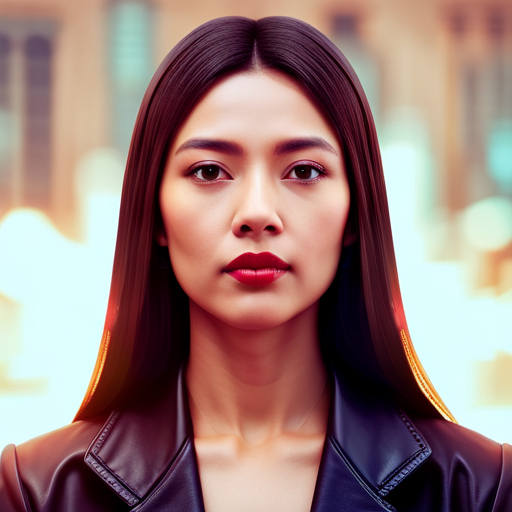Are you ready to unlock the incredible potential of AI for image generation?
In this comprehensive guide, you’ll delve into the basics of AI, gain an understanding of neural networks, and explore various AI models.
Discover how to train and fine-tune these models to create stunning, realistic images.
Get ready to witness the applications of AI image generation and explore the exciting future developments in this rapidly evolving field.
Don’t miss out on this opportunity to harness the power of AI.
Key Takeaways
– AI uses complex algorithms and deep learning techniques to create realistic images.
– Different AI models such as GANs, VAEs, CNNs, RNNs, and Transformers have unique strengths and weaknesses for image generation.
– Training and fine-tuning AI models involves adjusting hyperparameters and evaluating metrics like loss and accuracy.
– AI image generation has applications in various fields including entertainment, advertising, healthcare, and art, and holds potential for further advancements in accuracy and integration with emerging technologies.
The Basics of AI for Image Generation
@ Midjourney AI Image Prompt: /imagine prompt:Create an image showcasing the intricate layers of a neural network, with nodes interconnected through vibrant, glowing pathways. This visual representation captures the essence of AI for image generation and its complex yet captivating nature. –v 5.2 –ar 16:9
AI can create realistic images by using complex algorithms and deep learning techniques. With the advancements in artificial intelligence, generating images has become more sophisticated and accurate than ever before. By training AI models on vast amounts of data, it can learn to understand patterns, shapes, colors, and textures to create stunning visuals.
The process starts with feeding the AI model with a large dataset of images. This dataset serves as the foundation for the AI to learn from. The more diverse and extensive the dataset, the better the AI can generate images that match the desired criteria. Through complex algorithms and deep learning techniques, the AI model analyzes the dataset and identifies common features and patterns.
Once the AI model has learned from the dataset, it can generate new images by combining and manipulating these learned features. By adjusting parameters and input specifications, you can influence the output of the AI-generated images. This level of control allows you to tailor the generated images to your specific needs and preferences.
AI for image generation has numerous applications, ranging from art and design to entertainment and advertising. It can assist artists in creating unique and visually striking pieces, help designers explore various concepts and possibilities, and enable marketers to create captivating visuals for their campaigns.
Understanding Neural Networks for Image Generation
@ Midjourney AI Image Prompt: /imagine prompt:Create an image showcasing a complex neural network with multiple interconnected layers, each illustrated with vibrant colors and intricate patterns, symbolizing the powerful capabilities of AI in generating stunning and realistic images. –v 5.2 –ar 16:9
To understand how neural networks generate images, it’s important to grasp the concept of backpropagation. Backpropagation is a fundamental algorithm in machine learning that allows neural networks to learn from their mistakes and adjust their parameters accordingly. It works by calculating the gradient of the loss function with respect to each parameter in the network, and then using this information to update the parameters in the opposite direction of the gradient.
In the context of image generation, backpropagation is used to train a neural network to generate realistic images. The network is typically trained on a large dataset of real images, and during the training process, it learns to generate images that resemble the ones in the dataset. By iteratively adjusting the parameters of the neural network using backpropagation, the network gradually improves its ability to generate high-quality images.
One of the key advantages of using neural networks for image generation is their ability to capture complex patterns and generate realistic images. Neural networks are capable of learning intricate features and structures from the training data, allowing them to generate images that are visually appealing and indistinguishable from real images. This makes them particularly useful in applications such as image synthesis, style transfer, and even deepfake generation.
Exploring Different AI Models for Image Generation
@ Midjourney AI Image Prompt: /imagine prompt:Create an image showcasing a gallery of diverse and stunning AI-generated images, each reflecting the unique styles of popular image generation models like GANs, VAEs, and StyleGANs. –v 5.2 –ar 16:9
When exploring different models for image generation, you can experiment with various architectures and techniques to achieve the desired results. It’s important to understand that there is no one-size-fits-all approach in AI. Each model has its strengths and weaknesses, and it’s up to you to find the one that suits your needs.
To help you navigate through the vast landscape of AI models, here are some popular options along with their key features:
| Model | Architecture |
|---|---|
| GANs (Generative Adversarial Networks) | Consists of a generator and a discriminator network, which compete against each other to generate realistic images. |
| VAEs (Variational Autoencoders) | Combines a probabilistic encoder and a decoder to generate images. It focuses on learning the underlying distribution of the training data. |
| CNNs (Convolutional Neural Networks) | Utilizes convolutional layers to extract features from images and generate new ones based on the learned patterns. |
| RNNs (Recurrent Neural Networks) | Processes sequential data and can be used for generating images one pixel at a time. |
| Transformers | Utilizes self-attention mechanisms to capture global dependencies and generate high-quality images. |
Training and Fine-Tuning AI Models for Image Generation
@ Midjourney AI Image Prompt: /imagine prompt:Create an image showcasing an AI model training process, portraying a network of intricate neural pathways, where complex patterns and gradients intertwine, symbolizing the power and versatility of AI in generating visually stunning images. –v 5.2 –ar 16:9
To train and fine-tune your AI models for image generation, you should experiment with different hyperparameters and datasets to achieve optimal results.
Hyperparameters are the settings that control the behavior of your AI model during training. By adjusting these parameters, such as the learning rate, batch size, and number of layers, you can influence how your model learns and generates images. It’s important to try out different combinations of hyperparameters to find the ones that work best for your specific task.
In addition to hyperparameters, the choice of dataset also plays a crucial role in training your AI models for image generation. A diverse and representative dataset can help your model learn a wide range of patterns and generate more realistic and varied images. You can try using publicly available datasets like ImageNet or COCO, or create your own dataset by gathering images relevant to your specific application.
Furthermore, it’s important to regularly evaluate the performance of your AI models during training. This can be done by calculating metrics like loss, accuracy, or perceptual quality. By monitoring these metrics, you can identify any issues or areas for improvement and make necessary adjustments to your model or training process.
Applications and Future Developments in AI Image Generation
@ Midjourney AI Image Prompt: /imagine prompt:Create an image showcasing a vibrant futuristic cityscape filled with AI-generated artworks displayed on towering holographic screens, illustrating the limitless potential and future advancements in AI image generation. –v 5.2 –ar 16:9
If you want to stay up-to-date on the latest advancements in AI image generation, you should follow the latest research papers and attend conferences and workshops dedicated to the field. The field of AI image generation is constantly evolving, with new applications and future developments emerging regularly. By staying informed, you can not only gain valuable insights into the current state of the field but also get a glimpse into its exciting future.
One of the key applications of AI image generation is in the field of entertainment and media. AI algorithms can be used to generate realistic images, animations, and special effects, enhancing the visual experience in movies, video games, and virtual reality environments. Additionally, AI-generated images can also be used in advertising and marketing campaigns to create eye-catching visuals that attract and engage audiences.
In the field of healthcare, AI image generation is being used to improve medical diagnostics and treatment planning. By training AI models on large datasets of medical images, researchers are able to develop algorithms that can generate detailed and accurate representations of various medical conditions. This can aid in the early detection of diseases and assist doctors in making more informed decisions about patient care.
Another exciting development in AI image generation is the use of generative models to create art and design. Artists and designers are leveraging AI algorithms to generate unique and visually stunning images, patterns, and designs. This fusion of human creativity and AI technology is pushing the boundaries of traditional art forms and opening up new avenues for artistic expression.
In conclusion, the applications and future developments in AI image generation are vast and diverse. Whether it’s in entertainment, healthcare, or art, AI is revolutionizing the way we create and interact with images. By staying connected to the latest research and attending relevant events, you can stay at the forefront of this exciting field.
| Applications | Future Developments | Benefits |
| Entertainment and Media | Improved visual experience in movies, video games, and virtual reality | Enhanced audience engagement |
| Healthcare | Improved medical diagnostics and treatment planning | Early disease detection and better patient care |
| Art and Design | Creation of unique and visually stunning images, patterns, and designs | Pushing the boundaries of traditional art forms |
Frequently Asked Questions
What Are the Ethical Considerations Surrounding Ai-Generated Images?
When it comes to AI-generated images, ethical considerations come into play. You need to consider issues like privacy, consent, and potential misuse. It’s important to be mindful of the implications and impact of these images.
How Does AI Image Generation Compare to Traditional Methods of Image Creation?
AI image generation offers advantages over traditional methods. It can quickly create realistic images and doesn’t require manual effort. With AI, you can generate images in a fraction of the time and explore new creative possibilities.
Can Ai-Generated Images Be Used for Commercial Purposes Without Infringing on Copyright Laws?
You can use AI-generated images for commercial purposes without infringing on copyright laws as long as you have the necessary rights or permissions to use the original images or the AI-generated ones.
What Are the Limitations and Challenges of Using AI for Image Generation?
Using AI for image generation comes with limitations and challenges. It can struggle with creating realistic details and may produce inaccurate or biased results. Additionally, training the AI requires substantial computational resources.
Are There Any Specific Industries or Fields Where AI Image Generation Has Shown Significant Advancements and Impact?
In specific industries and fields, AI image generation has made significant advancements and shown great impact. It has revolutionized sectors like advertising, entertainment, fashion, gaming, and even healthcare, enhancing creativity and efficiency.
Conclusion
Now that you’ve delved into the world of AI for image generation, you’ve gained a comprehensive understanding of its power and potential.
From the basics of AI to the intricacies of neural networks, you’ve explored different AI models and learned how to train and fine-tune them.
With applications ranging from art and design to healthcare and entertainment, the future of AI image generation holds endless possibilities.
So go ahead, embrace the power of AI and unlock a whole new level of creativity and innovation.



